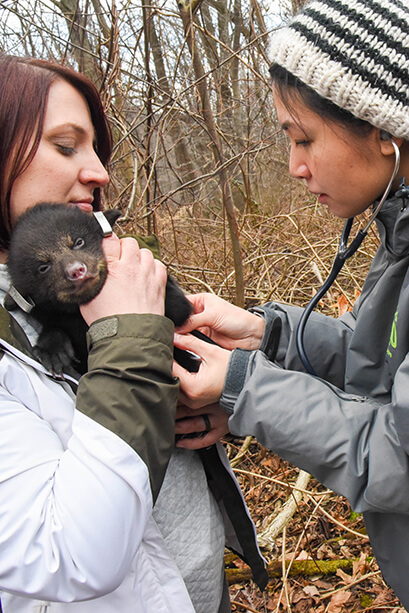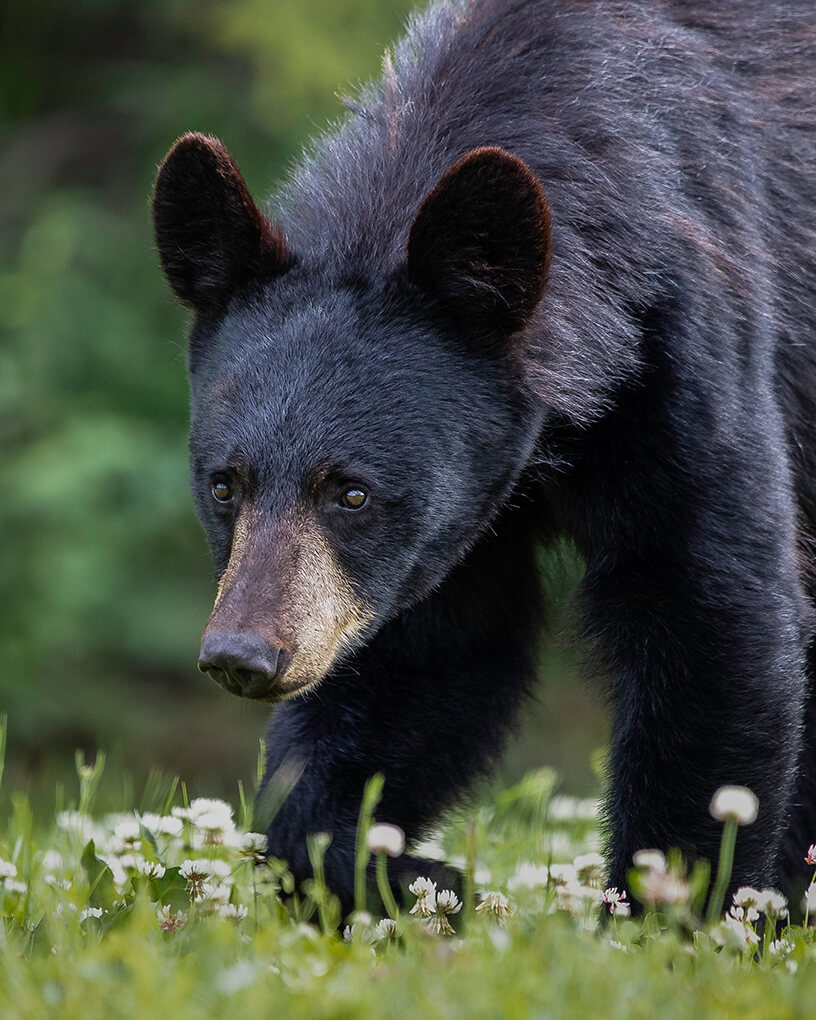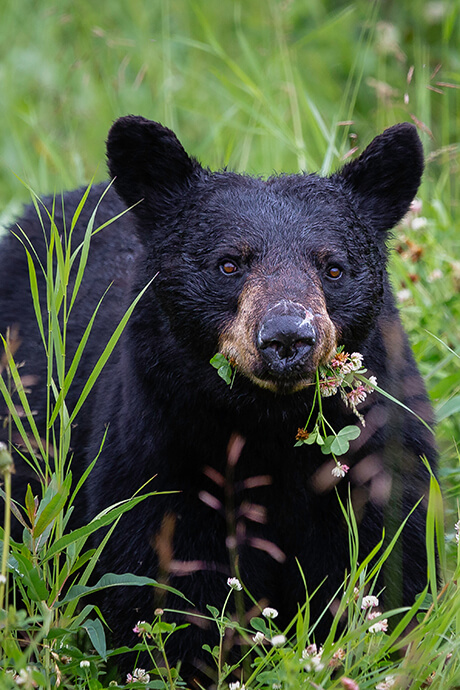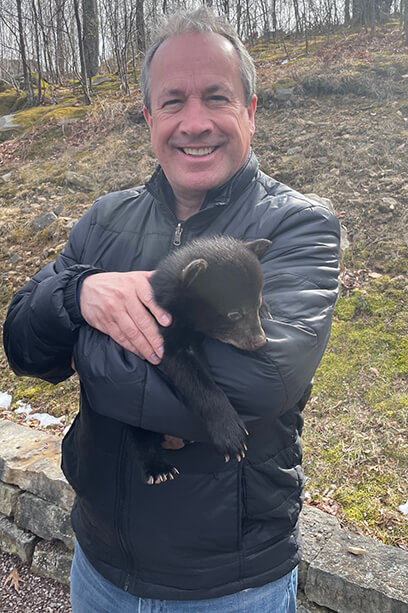The Giraffe House is currently closed for Kipi and her calf.
While driving west from Baltimore early one morning this past March, as fog lifted off the mountains, Laura Newman worried. An educator at the Maryland Zoo, Newman was traveling with two of the Zoo’s veterinarians and listening to Dr. Ellen Bronson, Senior Director of Animal Health, Research & Conservation, relate tales of past trips to western Maryland to assist state biologists from the Department of Natural Resources (DNR) in their annual assessment of black bear sows and cubs. This was Newman’s first time participating in the decades-old partnership between DNR and the Zoo, and she was learning that sometimes the fieldwork could be physically challenging.
“I was just thinking of all the ways I might mess this up – for Dr. Ellen, for the Zoo, for DNR, for the black bears of Maryland,” recalls Newman with self-deprecating flourish. As it turns out, she had no reason to worry. She and the veterinarians met up with the DNR team and drove to the site of a den inhabited by a black bear sow and four cubs.
“We parked within 100 feet of the den,” says Newman. “In the driveway of a gorgeous home,” she laughs. “Dr. Ellen talked about bush-whacking and wading through muck, all this and that, and I literally had steps down to the den.” (Kaitie Kessler, a Zoo Hospital keeper who attended a separate den visit, had a very different experience. “Rain, sleet, snow, and mud,” she recalls, “and a bear wedged in tight under a fallen tree.”)


This particular bear had burrowed beneath a shed on the property, where she gave birth, nursed her cubs, and dozed away the winter. Over the next few hours, Newman would hold her first bear cub, keeping it warm inside her jacket, while Zoo veterinarians assisted DNR biologists in monitoring and assessing the mother and her four healthy offspring.
“The Zoo vets play a huge role in this work and bring tremendous expertise to the table,” says Brian Eyler, Game Mammal Section Leader for DNR and a veteran manager of both black bears and white-tailed deer. “We can trust that they know exactly what they are doing, and that makes things so much easier on us. It is an important partnership for sure.”
During this health check, curious onlookers gathered to see what was going on, and rather than keeping them at bay, the DNR team called them over and explained exactly what they were doing and why. Every March, DNR biologists visit black bear dens to check on mothers and cubs and determine how many new males and females are entering the population. In order to do this work safely, they must anesthetize the sow, but when the check is over, they carefully reunite the bear family inside the den so that when mom wakes up, her cubs are right beside her. These den visits, usually involving sows that have been collared years prior so that they can be tracked, are one of several important data-collection tools that inform DNR’s management of the overall black bear population in Maryland.
“It was really neat to see how the DNR folks were able, right there in the moment, to engage people and build relationships and lay the foundation for what a cool experience it can be, should one of them have a bear on their property in the future,” says Newman. “Pulling back the curtain as they did, and explaining what they’re doing, I think really helps to reach people and make them more open and willing to share space with bears.”
Neighbors in the Forest
As this female black bear demonstrated, many Marylanders are already sharing space with black bears quite successfully and often unwittingly. This is especially true in Maryland’s four most western counties – Garrett, Allegany, Frederick, and Washington – where the state’s black bear population is concentrated. Black bears are thriving in western forests, feeding on all that those forests have to offer (including a plentiful supply of acorns, hickory nuts, and other mast), largely out of sight of human neighbors.
“Maryland’s mix of habitats and the productivity of our hardwoods is really good for them,” explains Eyler. “But humans aren’t bad for black bears either,” he adds. “In fact, they’re quite good.” By that, he means that managed forests and clearings created by agriculture and development contribute to optimal habitat conditions for black bears.
“That variety of food sources is what black bears really need because their diet changes throughout the year, from berries in early spring to fresh vegetation to late fall when you have those hard masts,” says Jonathan Trudeau, DNR’s newly minted Black Bear Project Leader. “You need big openings in the canopy to allow for regeneration of those younger, earlier-stage plants like the berry shrubs and saplings and such, and you get that in areas that humans occupy.”

Take Care to be “Bear Aware”
Black bears go about their lives mostly unseen by people, foraging at dawn and dusk and keeping to the forest. Every year in western Maryland, though, there are cases of sows and cubs denning beneath porches or sheds, or of young bears exploring new territory in early summer, or unfortunately of bears being struck and killed while crossing roads.
There is also no denying that black bears are intelligent, curious, and opportunistic eaters. They will take advantage of artificial food sources if given the chance. Any self-respecting black bear that picks up the scent of a barbecue grill or stumbles upon a bird feeder full of seed is going to have to check it out. And as more than one frustrated farmer in those western counties may tell you, black bears love corn. And cornfields. And beehives.
To co-exist safely and successfully with black bears, you need to be “bear aware.”
Black Bears on the Move
“If you look at Garrett County where we’ve had black bears the longest, most of those folks know to take down their bird feeders at night and to put trash in bear-proof containers,” says Eyler. “But there is a learning curve to living with black bears, and as the bears move east, those education challenges move with them.”
He notes an uptick in calls from concerned citizens in counties such as Montgomery where black bears are becoming more common. When people unaccustomed to black bears see one near their property for the first time, they often want DNR to remove the bear. They worry that black bears may be dangerous. They are large animals, after all, with teeth and long claws.
Get to know black bears, though, and you come to appreciate that they are naturally timid and wary of people. Black bear attacks are exceedingly rare, especially in Maryland. Despite their teeth and claws, black bears are far more likely to run away than confront.
“Bears are on the landscape and bears belong on the landscape,” says Eyler. “And from a danger standpoint, they are low-risk. Not zero risk, but very low risk.”
It takes time, conversation, and lived experience for people to realize that simple behavioral adjustments can lead to peaceful co-existence. Bring in the bird feeders, barbecue grills, and pet food bowls. Secure your trash. Do not intentionally feed bears. Take steps not to attract them, however charismatic they may be, and that will work out best for you and the bears.
“If you see a bear, treat it with the same mentality that you would a stranger’s dog,” advises Trudeau. “You don’t know how the dog might react. You also don’t know how this wild animal might react, so don’t put yourself in a situation of needing to find out. Just enjoy the bear from afar.”


Beehives, Corn Fields, and Tolerance
For most people, that is good advice and easy enough to follow. For agriculturists whose crops and honey are all too enticing to black bears, not so much. They confront a different set of challenges. Bee-keepers can install electric fences around hives to deter bears, and DNR will help with that. Farmers can receive partial compensation for crop damage caused by bears and can also seek a permit to harvest one bear per year to deter damage.
“It’s got to be extremely frustrating for farmers,” admits Eyler, knowing what a black bear loose in a cornfield can do. “But even the majority of farmers that are suffering damage, if you ask them whether there’s value to having black bears on the landscape, they will tell you yes. I don’t think there’s any risk of losing support for black bears. The general public sees the value of wildlife, and we are very fortunate from that standpoint.”
In fact, public support for black bears in Maryland has been critical to the species’ impressive recovery. Once prevalent throughout the state, black bears were driven to near-extinction over the course of the 18th, 19th, and 20th centuries. They landed on the state’s endangered species list in 1972. Just over a decade later – in 1985 – they were removed from that list. By then, black bears had reestablished themselves in the western mountains, a testament to their own resilience as well as to improving habitat conditions and human tolerance. Ever since, DNR has managed the black bear population to grow at a healthy, sustainable rate.
“The fact that the population has come back – that took management from us, but it also took a public that was willing to accept bears on the landscape,” says Eyler. “The change in attitude from 100 years ago to now is remarkable. There’s no doubt it’s been a conservation success story.”
A Story Worth Telling
It is a story that is still unfolding, of course, and one that deserves continued telling because it aptly demonstrates that people can successfully co-exist with all manner of wildlife so long as the will and the means are there. The Zoo and DNR share common interests in supporting Maryland’s native wildlife, promoting empathy and respect for wildlife, and encouraging people to accommodate wildlife on the landscape.


“We want to keep expanding our conservation programs both internationally and locally,” says Kirby Fowler, President & CEO of the Maryland Zoo, “and of course our most significant local partner is DNR. To be able to assist them in their work with black bears is important for our morale and for our mission. It goes directly to our belief that conserving native wildlife – what’s in our backyard, so to speak – is just as important as conserving wildlife anywhere else in the world.”
It is also gratifying. Ask anyone who has now held a black bear cub and witnessed the Zoo and DNR teams in action together.
“It was just incredible,” says Fowler.
“I loved it,” says Kessler.
“It was exactly as amazing as I had thought it might be,” says Newman.
 BACK TO STORIES
BACK TO STORIES
 MORE ZOOGRAM STORIES
MORE ZOOGRAM STORIES